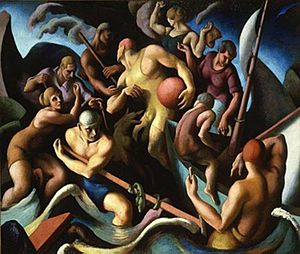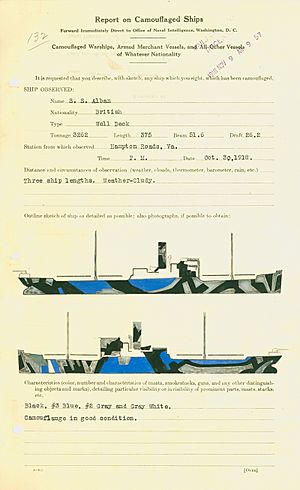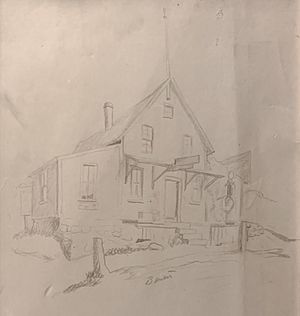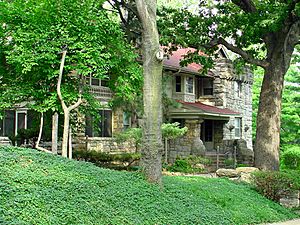Thomas Hart Benton (painter) facts for kids
Quick facts for kids
Thomas Hart Benton
|
|
|---|---|

Benton in 1935
|
|
| Born | April 15, 1889 Neosho, Missouri, U.S.
|
| Died | January 19, 1975 (aged 85) Kansas City, Missouri, U.S.
|
| Alma mater | The School of The Art Institute of Chicago Académie Julian |
| Known for | Painting |
|
Notable work
|
America Today (1930-31) Indiana Murals (1933) Social History of Missouri (1936) Persephone (1938-39) |
| Movement |
|
Thomas Hart Benton (born April 15, 1889 – died January 19, 1975) was an American painter, muralist, and printmaker. He was a leader of the Regionalist art movement, along with artists like Grant Wood and John Steuart Curry. His paintings showed everyday people and scenes from life across the United States.
Benton's art is often connected to the Midwestern United States, where he was born and lived for most of his life. However, he also studied art in Paris, lived in New York City for over 20 years, and spent summers on Martha's Vineyard. He painted scenes from the American South and the American West too.
Contents
Thomas Hart Benton's Early Life
Benton was born in Neosho, Missouri. His family was well-known in politics. His father, Colonel Maecenas Benton, was a lawyer and was elected to the U.S. Congress four times. Thomas Hart Benton was named after his great-uncle, Thomas Hart Benton, who was one of Missouri's first United States Senators.
Because his father was a politician, Thomas spent his childhood moving between Washington, D.C. and Missouri. His father wanted him to follow a political path and sent him to a military academy. But Thomas was more interested in art, and his mother supported this. As a teenager, he worked as a cartoonist for a newspaper in Joplin, Missouri.
In 1907, with his mother's help, Benton enrolled at The School of The Art Institute of Chicago. Two years later, in 1909, he moved to Paris to study art at the Académie Julian. His mother continued to support him financially and emotionally. In Paris, Benton met other artists, including Diego Rivera from Mexico and Stanton Macdonald-Wright. Macdonald-Wright influenced Benton to try a style called Synchromism, which focused on color and form.
Art and World War I
After studying in Europe, Benton moved back to New York City in 1912 and continued painting. During World War I, he served in the U.S. Navy in Norfolk, Virginia. His work during the war greatly influenced his art style. He was asked to draw and illustrate shipyard work and daily life. This need to create realistic drawings made his later art very detailed and true to life.
Later in the war, Benton was a "camoufleur". This meant he drew the camouflaged ships that came into Norfolk harbor. His drawings helped make sure U.S. ships were painted correctly and provided records of Allied ships. Benton later said this Navy work was "the most important thing" he had done for himself as an artist.

Family Life
In 1922, when he was 33, Benton married Rita Piacenza, who was from Italy. They met in New York City, where Benton was teaching art and Rita was his student. They were married for nearly 53 years until Benton's death in 1975. Rita passed away just eleven weeks after him. They had a son named Thomas Piacenza Benton and a daughter named Jessie Benton.
Later Career and Regionalism

When Benton returned to New York in the early 1920s, he decided to paint in a more realistic style, which became known as Regionalism. He traveled across America, making sketches of the things he saw. He used these sketches again and again for his future paintings.
His Regionalist works grew larger, leading to his famous America Today murals. These were painted for the New School for Social Research in New York in 1930–31. Later, these murals were bought and moved to the AXA Equitable Tower. In 2012, AXA donated them to the Metropolitan Museum of Art, where they have been displayed.
In 1932, Benton became more widely known. He was chosen to paint murals about life in Indiana for the 1933 Century of Progress Exhibition in Chicago. These Indiana Murals caused some debate. Benton painted everyday people and included parts of the state's history that some people didn't want to be shown. For example, he showed members of the Ku Klux Klan (KKK), which was a powerful group in Indiana at that time. Today, these murals are displayed at Indiana University in Bloomington.
Also in 1932, Benton painted The Arts of Life in America for the Whitney Museum of American Art. These large murals included panels like Arts of the City and Arts of the West. Five of these panels are now at the New Britain Museum of American Art in Connecticut.
On December 24, 1934, Benton was featured on the cover of Time magazine. His work, along with that of Grant Wood and John Steuart Curry, was highlighted in an article about "The U.S. Scene." These three artists were seen as new heroes of American art, and Regionalism was recognized as an important art movement.
In 1935, Benton left New York and returned to his home state of Missouri. He was asked to create a mural for the Missouri State Capitol in Jefferson City. This mural, A Social History of Missouri, is often considered his greatest work. Benton said in 1973, "If I have any right to make judgments, I would say that the Missouri mural was my best work." Like his earlier murals, this one also caused some discussion because it showed difficult parts of Missouri's history, such as slavery and famous outlaws like Jesse James.
Benton settled in Kansas City and began teaching at the Kansas City Art Institute. This allowed him to see more of rural America, which was changing quickly. Because of his background, Benton felt a connection to working-class people and small farmers. His art often showed the feelings and beauty of small-town life. In the late 1930s, he created Persephone, one of his most famous works. It is now at the Nelson-Atkins Museum of Art in Kansas City.
In 1937, Benton published his autobiography, An Artist in America, which was praised by critics. The writer Sinclair Lewis said, "Here’s a rare thing, a painter who can write." During this time, Benton also started making signed, limited-edition lithographs, which are types of prints.
Teaching Art
Benton taught art at the Art Students League of New York from 1926 to 1935. He also taught at the Kansas City Art Institute from 1935 to 1941. His most famous student was Jackson Pollock, who later became a leader of the Abstract Expressionist movement. Pollock often said that Benton's traditional teaching gave him ideas to react against in his own art.
Benton's students included many artists who became important in American art. Some of them were Charles Pollock (Jackson's brother), Eric Bransby, Charles Banks Wilson, Reginald Marsh, and Dennis Hopper, who later became a famous actor and filmmaker.
Later Years and Legacy
During World War II, Benton created a series of works called The Year of Peril. These showed the dangers that fascism and Nazism posed to American ideas. After the war, Regionalism became less popular, as Abstract Expressionism became more common. However, Benton continued to paint for another 30 years. His later work often showed pre-industrial farmlands rather than current social issues.
In 1940, Benton was one of several artists hired to document the making of the film The Long Voyage Home. Benton was also a talented harmonica player. He even recorded an album in 1942 called Saturday Night at Tom Benton's.
He continued to paint murals, including Lincoln (1953) for Lincoln University and Independence and the Opening of the West for the Harry S. Truman Library. His work on the Truman Library mural led to a friendship with former U.S. President Harry S. Truman.
Thomas Hart Benton died in 1975 while working in his studio. He was finishing his last mural, The Sources of Country Music, for the Country Music Hall of Fame in Nashville, Tennessee.
Honors and Home
Benton was recognized for his art throughout his life. He was elected into the National Academy of Design in 1954. In 1961, he was honored as one of 50 outstanding Americans by the Academy of Achievement.
In 1977, Benton's home and studio in Kansas City were named the Thomas Hart Benton Home and Studio State Historic Site. The house museum has been kept almost exactly as it was when he died. His clothing, furniture, and paint brushes are still there. The site displays 13 of his original artworks and offers guided tours. A 1988 documentary film about him, Thomas Hart Benton, was directed by Ken Burns.
See also
 In Spanish: Thomas Hart Benton para niños
In Spanish: Thomas Hart Benton para niños





